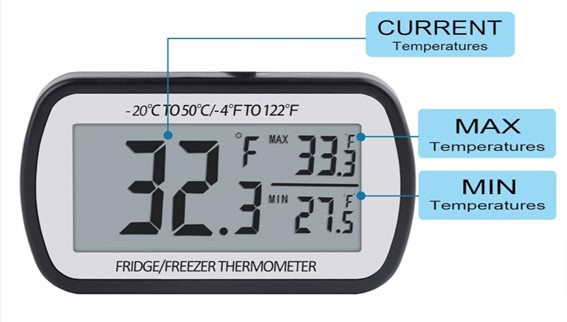Did you know that a mere 2°F temperature swing can accelerate your wine’s aging process by up to 30%?
As a wine enthusiast and collector for many years, I’ve seen countless collections compromised by improper temperature control. Wine Temperature fluctuations are perhaps the most significant threat to quality, affecting everything from the cork’s integrity to the complex chemical reactions that define a wine’s character.
In this comprehensive guide, we’ll explore why stability matters and how to protect your precious bottles from temperature-related damage.
Welcome to Didi Somm, and Cheers!
Important Notice: The information in this article is for general and public information purposes only. It solely reflects Didi Somm’s or his Staff’s opinion, and no responsibility can be assumed for errors or omissions in the service’s contents. For details, please check the Disclaimer at the bottom of the homepage.
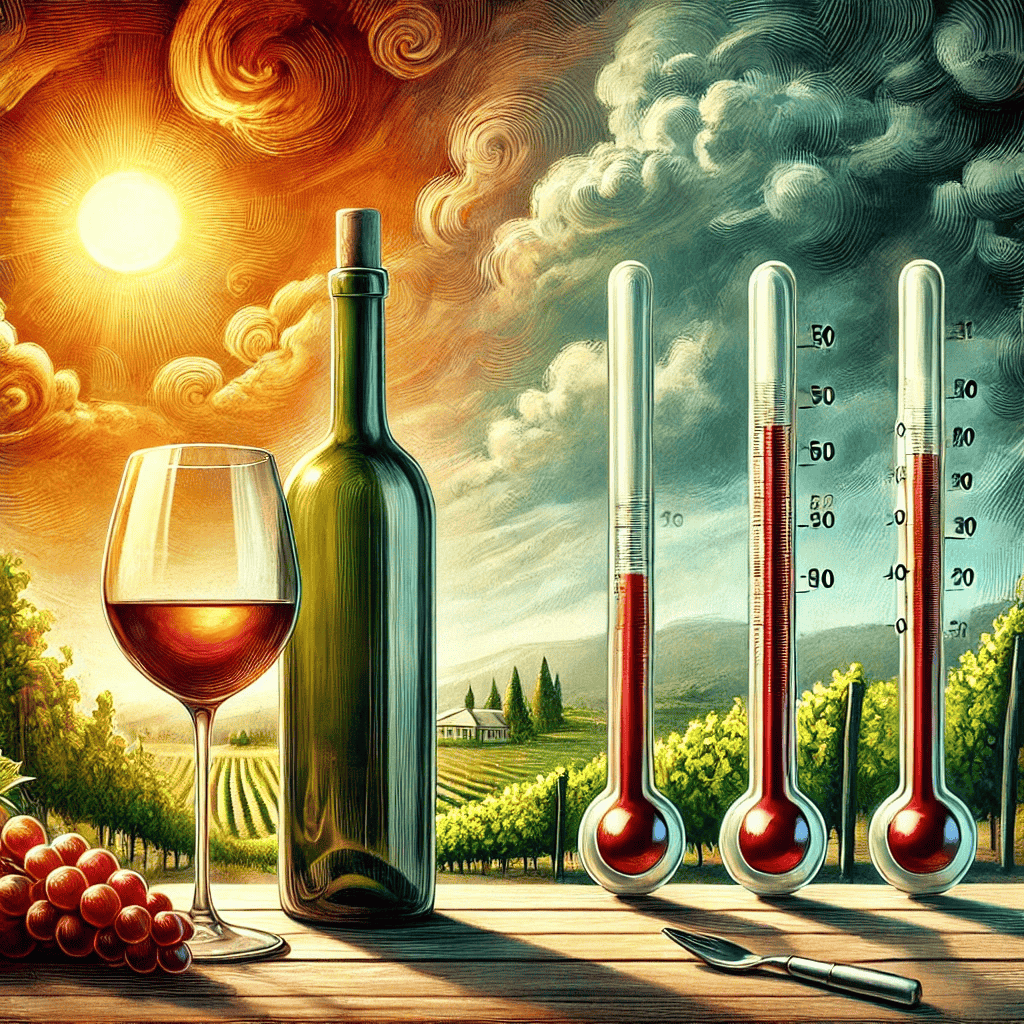
Key Takeaways
- Temperature fluctuations can significantly accelerate wine aging and potentially damage wine quality
- Optimal storage temperature ranges from 53-57°F (12-14°C)
- Daily temperature variations should not exceed 3°F
- Proper insulation and dedicated wine storage solutions are essential for maintaining stability
- Heat exposure poses a greater threat to wine quality than cold exposure
Understanding the Science Behind Temperature’s Effect on Wine
Let me tell you something fascinating I learned during my sommelier certification – wine is basically a living chemistry experiment in a bottle!
After spending years studying wine storage, I’ve come to appreciate the delicate dance of molecules that happens inside each bottle. Here’s the deal: every 10°F increase in temperature roughly doubles the rate of chemical reactions in wine. That’s why I always tell my students that heat is like pressing fast-forward on your wine’s aging process.
The tannins, those compounds that give red wine its structure, become more reactive at higher temperatures, leading to premature aging. I once had a collector bring me a bottle of premium Bordeaux that had been stored in his garage during a heatwave – the wine had completely fallen apart, with those beautiful tannins turning harsh and bitter.
The esters, which give wine its fruity aromas, are particularly sensitive to temperature changes. They break down faster in warm conditions, causing your wine to lose its vibrant fruit characteristics. Dissolved oxygen levels also increase with temperature, accelerating oxidation and potentially turning your prized bottle into something resembling vinegar.
And don’t get me started on the pressure changes inside the bottle – even minor wine temperature fluctuations can cause the cork to move slightly, allowing more oxygen to seep in.
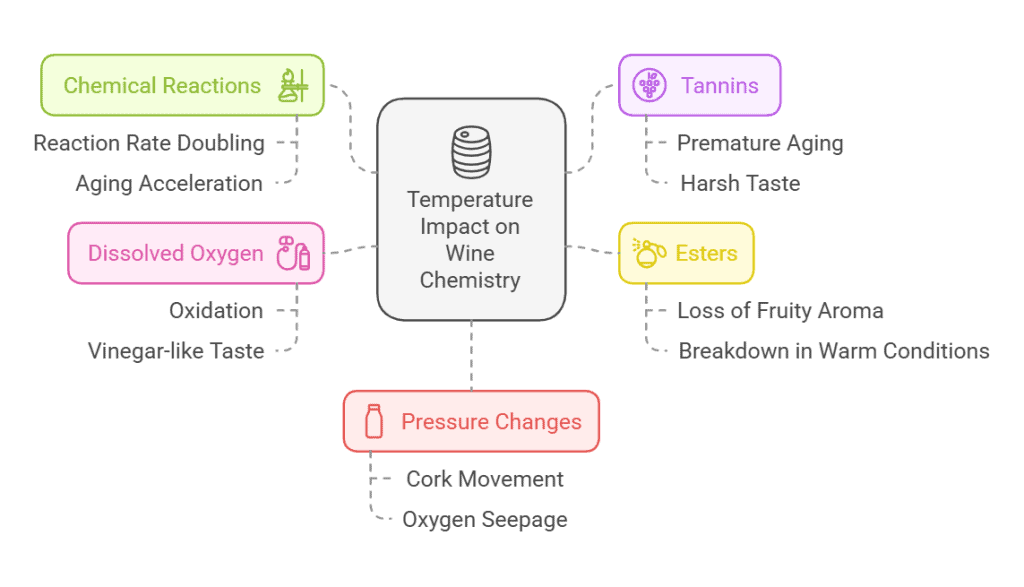
Affiliate Disclaimer: This page may include Affiliate links, meaning that we get a commission if you decide to purchase through this site at no extra cost to you. Please read our Disclaimer for your info.
Common Causes of Wine Temperature Fluctuations in Storage
During my consulting work with private collectors, I’ve seen some real head-scratchers when it comes to wine storage locations.
One client couldn’t figure out why his wines were aging prematurely until we discovered his wine fridge was sitting right next to his kitchen’s exhaust vent! Daily temperature swings are often the sneakiest culprit – that sunny window might look great for displaying bottles, but it’s a wine collection’s worst enemy. I’ve noticed that seasonal changes can be particularly tricky in regions with extreme weather patterns. Your HVAC system might be working overtime, but those cycling patterns create micro-fluctuations that add up over time.
Light exposure is another silent killer – I learned this the hard way when I stored some white wines near a window with “UV protection.” Spoiler alert: The protection wasn’t enough. Heat-producing appliances are everywhere in modern homes, and they’re not always obvious. I once found a client’s wine cooler was struggling because it was positioned right above a hidden water heater!
Building insulation quality plays a huge role, too – I’ve seen temperature differences of up to 5°F between identical wine fridges in well-insulated versus poorly insulated spaces.
Summary – Common Causes of Wine Temperature Fluctuations
| Cause | Description | Example or Insight |
|---|---|---|
| Proximity to Heat Sources | Wine storage near heat-producing appliances or areas can lead to premature aging due to temperature swings. | Wine fridge placed near a kitchen exhaust vent or above a hidden water heater. |
| Daily Temperature Swings | Regular exposure to fluctuating temperatures, often from sunny windows or unregulated spaces. | A sunny window used for displaying bottles. |
| Seasonal Weather Changes | Extreme weather patterns can strain HVAC systems, leading to micro-fluctuations in wine storage temperatures. | HVAC cycling in regions with extreme seasonal changes. |
| Light Exposure | UV light or direct sunlight can cause heat and damage to wine, even with partial UV protection. | White wines stored near a window with insufficient UV protection. |
| Building Insulation | Poor insulation can cause uneven temperatures, even in controlled storage environments. | Identical wine fridges showing temperature differences of up to 5°F due to insulation quality. |
Identifying Signs of Temperature-Damaged Wine
After examining thousands of bottles over my career, you develop a sort of “sixth sense” for temperature damage.
Visual Clues
The visual clues are usually the first tip-off – I remember picking up a bottle of Champagne and immediately noticing the label had slight rippling near the edges, a classic sign of heat exposure. Cork condition is like a wine’s vital sign – if you see it pushing up against the capsule or wine seeping around the edges, that’s your red flag right there.
Aromatics
The aromatics tell another story – I once opened a heat-damaged Pinot Noir that had lost all its delicate cherry notes and instead smelled like stewed prunes. Not exactly what you want from a $100 bottle! The taste profile changes can be subtle or dramatic. Heat-damaged wines often develop a jammy, cooked fruit character that masks their terroir.
Physical Signs
Physical signs on the bottle itself can be revealing – I teach my students to look for sticky residue on the bottle’s neck, which indicates that wine has expanded and pushed against the cork.
The long-term effects on aging potential are perhaps the most heartbreaking – I’ve seen beautiful wines that should have aged gracefully for decades reduced to flat, lifeless shadows of their potential within just a few years due to poor temperature control.
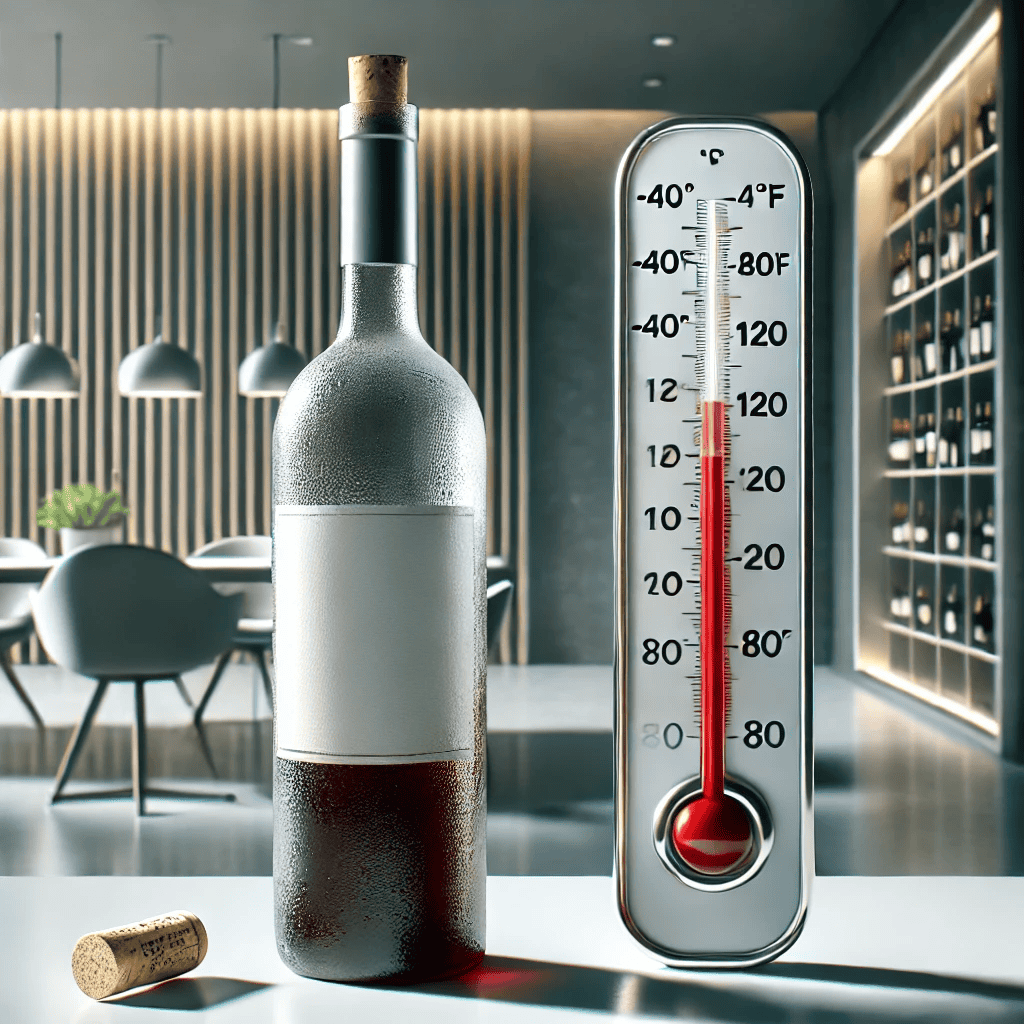
Best Practices for Temperature Stability
Through years of trial and error (and, yes, some painful lessons), I’ve developed a pretty solid approach to temperature stability.
Location
First things first – location is everything. I always tell my clients that the perfect wine storage spot is like real estate: it’s all about location, location, location! The ideal space should be naturally cool and away from external walls.
Insulation
Insulation is crucial – I learned this after spending a small fortune on electricity bills trying to maintain temperature in a poorly insulated space. Now, I insist on at least R-19 insulation in walls and R-30 in ceilings for any serious wine storage area.
Temperature Monitoring & Seasonal Adjustments
Temperature monitoring is another non-negotiable – I use a dual-probe system that tracks both ambient temperature and humidity. The best $200 I ever spent was on a backup power system for my wine fridge after losing power during a summer heatwave. Seasonal adjustments are something many collectors overlook – I adjust my cooling settings slightly with the seasons to maintain stability.
Professional Storage
And while professional storage might seem expensive (trust me, I get it), it’s a lot cheaper than replacing a damaged collection. I’ve seen too many collectors learn this lesson the hard way.
Pro Tip: To check the actual services of companies in this industry, I recommend checking the following websites: UOVO Wine, The Lock Up, or America’s Top Wine Storage Facilities (an article published by The Chicago Wine & Sommelier School).
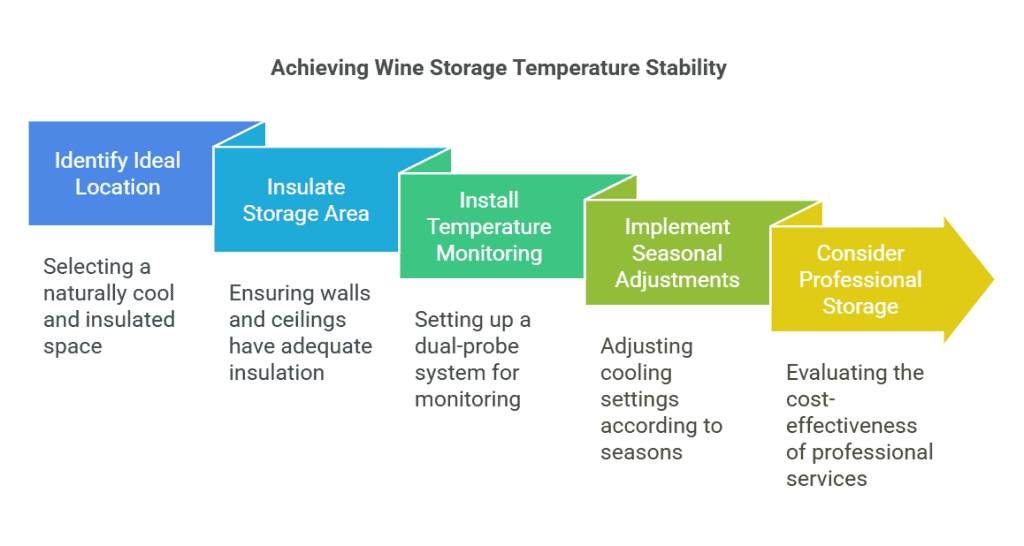
Advanced Storage Solutions and Technologies
Boy, has wine storage technology come a long way since I started in this field!
The modern wine refrigeration systems we have now are like something out of a sci-fi movie compared to the basic cooling units I used to work with. I recently installed a smart monitoring system in my cellar that sends alerts to my phone if there’s even a 2°F temperature swing – talk about peace of mind!
The principles of thermal mass have revolutionized how we design wine rooms. I’m a huge fan of incorporating materials like concrete or stone walls, which help maintain temperature stability naturally.
Humidity control integration is another game-changer – the latest systems can maintain that perfect 70% humidity level without making your cooling system work overtime. Emergency alert systems have saved more than a few collections in my experience – I remember getting an alert at 3 AM about a power failure and being able to take action before any damage occurred.
The latest innovations in wine preservation are mind-blowing – from argon gas preservation systems to vibration-dampening materials in wine racks. However, I have to admit, sometimes the best solution is still the simplest: A well-insulated room with a reliable cooling system and proper monitoring.

FAQ – Wine Temperature Fluctuations
- Q: What is the ideal temperature for storing wine? A: The optimal storage temperature for most wines is between 53-57°F (12-14°C), with minimal fluctuation.
- Q: How quickly can temperature fluctuations damage wine? A: Significant damage can occur within hours if temperatures exceed 77°F (25°C), while subtle changes may take weeks or months to develop.
- Q: Are red wines more sensitive to temperature fluctuations than white wines? A: Generally, red wines are more resilient due to higher tannin content, but all wines are susceptible to temperature damage.
- Q: Can wine recover from brief temperature exposure? A: Minor, brief temperature fluctuations may not cause permanent damage, but repeated exposure or extreme temperatures can cause irreversible changes.
- Q: What’s worse for wine: heat or cold? A: Heat is generally more damaging than cold, as it accelerates chemical reactions and can cause permanent changes to the wine’s structure.
- Q: How do I know if my wine has been heat-damaged? A: Look for signs like pushed-up corks, leakage, reduced fill levels, and premature aging characteristics in taste and aroma.
- Q: Does wine insurance cover temperature-related damage? A: Some specialized wine insurance policies cover temperature damage, but standard policies typically don’t. Pro Tip for Wine Insurance: Please check the following specialized US Wine insurers, InsureMyWine or HORTEN, for details.
- Q: Can I store wine in an unheated garage? A: It’s not recommended due to significant temperature fluctuations that occur in most garages.
- Q: What’s the minimum investment needed for proper temperature control? A: A basic wine refrigerator starts at $200-300, while professional-grade solutions can cost thousands.
- Q: How often should I check storage temperature? A: Daily monitoring is ideal, with at least weekly checks recommended for serious collectors.
- Q: Can temperature fluctuations affect wine bottle labels? A: Yes, temperature changes can cause label damage through condensation and humidity variations.
- Q: What’s the best way to transport wine in varying temperatures? A: Use insulated shipping containers or wine-specific travel cases, and avoid transportation during extreme weather.
- Q: How long can wine safely remain at room temperature? A: Generally, wine shouldn’t be stored at room temperature for more than a few weeks to maintain optimal quality.
- Q: Do temperature fluctuations affect sparkling wines differently? A: Yes, sparkling wines are particularly sensitive due to their carbonation and pressure dynamics.
- Q: Can I use a regular thermometer to monitor wine storage? A: While possible, it’s better to use wine-specific thermometers that can track fluctuations over time.
Conclusion
Understanding and controlling temperature fluctuations is crucial for preserving wine quality and ensuring optimal aging conditions.
By implementing proper storage solutions and monitoring systems, you can protect your wine investment and enjoy each bottle at its peak potential. Remember, consistency is key – it’s better to maintain a slightly higher but stable temperature than to have significant fluctuations within the ideal range.
Take action today to assess your current storage conditions and make necessary improvements to safeguard your collection.
Good luck with your wine collection, enjoy, and cheers!
For your reference, the latest articles by Didi Somm include:
- Compact Wine Fridges: Best Advice For You
- How To Organize Wine Fridge: Expert Guide 2025
- Best Wine Refrigerators For Every Budget: Expert Guide
- Insights on Long-term Wine Storage: Your Best Expert Guide
- 10 Essential Wine Aging Factors: All You Need To Know
- Wine Bottle Positioning: Best Expert Advice
Important Notice: The information in this article is for general and public information purposes only. It solely reflects Didi Somm’s or his Staff’s opinion, and no responsibility can be assumed for errors or omissions in the service’s contents. For details, please check the Disclaimer at the bottom of the homepage

